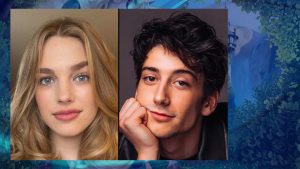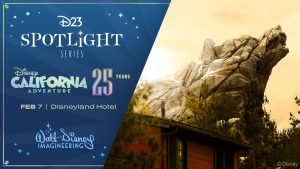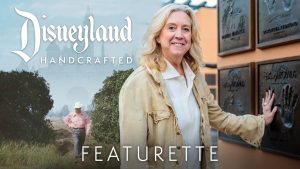 Mermaids played a pivotal role in Pirates of the Caribbean: On Stranger Tides. Special Effects Supervisor Ben Snow took a few minutes to sit down in a virtual round table and talk about some of the different aspects of making the movie, including mermaids.
Mermaids played a pivotal role in Pirates of the Caribbean: On Stranger Tides. Special Effects Supervisor Ben Snow took a few minutes to sit down in a virtual round table and talk about some of the different aspects of making the movie, including mermaids.
The mermaids in Pirates of the Caribbean: On Stranger Tides had to be both beautiful and dangerous. The process of creating them was not nearly as simple as one would guess. Ben Snow went into some of the process of creating the mermaids and then bringing them to life. Here are some excerpts from this virtual round table:
Q. Where did you get the ideas for the look of the mermaids from?
A. The look of the mermaids followed a lengthy discussion process with Rob Marshall and a lot of concept art exploration. In talking to Rob he showed us some previous design work that had been done as well as some classic paintings of mermaids, underwater fashion photography and even a couple of mermaid pinups. He told Aaron McBride, our VFX art director, and myself what he liked and didn’t like about this material. One image he liked had a woman in a sheer fabric tail that you could still see the outline of her legs through. He also talked a lot about the beauty of Astrid Berges-Frisby and how some of the previous concepts had been too creature-like. At the same time we had been looking at different types of marine life, and trying to tie the mermaid into the marine life feel of previous Pirates characters we wanted to integrate, and also discussed how she might actually transform. So we came up with a slightly scaly body covered with a sheer membrane. The idea was that when she was wet the membrane was transparent and you could see flashes of scales, but as she dried it became more like human skin. It was a fun process to invent the science behind these characters.
Q. When producing the mermaids-scenes, what where your inspirations for their movement and the general “look” of the mermaids?
A. We wanted to avoid the classic ‘woman in a mono-fin’ that has been seen in past mermaid films so we studied a variety of marine mammals and fish for the motion of the mermaids. We also had synchronized swimmers and professional athletes that we filmed on set to help guide the animation. As for the look, we were trying to create something different than what you’ve seen before but keep it rooted in reality. We used reference of sea life, human skin, etc. and also bought some fish at the fish market and photographed the heck out of them. In the end, the mermaids had a scaly body with a membrane of sheer, almost jelly-fish like, tendrils.
Q. Did Disney give you any guidelines as to how scary or dark you could go with the mermaids?
A. Yes, they actually encouraged us to really explore the scary side. In the end, Rob Marshall decided to reign back a little on the more creaturesque aspects and go for something which preserved more of the beauty of the original actresses. And I think this was the right decision – they still seem plenty scary enough.
Q. When you are working on an animated character, what is most important to you?
A. We want the character to be something unique and fantastic but also rooted enough in reality that it is believable. For the mermaids having the footage of marine animals and the swimmers and actors for reference in the filmed material helped make this possible.
Q. During the planning of the scenes, what were your major concerns for the final product?
A. Our major concerns were to deliver the best mermaids we could – to try and create definitive filmic mermaids, and to live up to the quality of work that we’ve seen in previous Pirates of the Caribbean films.
Q. What proved to be the biggest challenge in the making of the mermaid scenes?
A. The biggest challenge was the creative one of how much to play them as creatures and how much as human. Ultimately, Rob Marshall decided to keep them as human as possible, and that was itself a huge challenge because of a phenomenon that they call “The Uncanny Valley” in robotics. The more human something artificial starts looking, the creepier it looks. So it was a lot of work to make the CG mermaids more and more human looking, changing their seaweed hair to human hair and their faces to matching the actresses more exactly.
Q. Do you involve the actors in your work and if so, how?
A. Yes, we depend upon the collaboration of the actors in our work. One of the sequences we worked on had Jack Sparrow playing with a droplet of water and I had to draw dots on Johnny Depp’s fingers with a sharpie. He was very helpful and tolerant. Johnny and several of the other actors went through an elaborate photographic and scanning process so we could make digital versions of them if needed. For the mermaids, it was even more elaborate but they were great about it. We’d put them in these psychedelic bathing suits we had designed to make tracking them easier and blending the tails with their bodies, and painted dots all over their faces. Astrid Berges-Frisbey (the key mermaid) was a little concerned when we had to paint dots on her face for a key emotional scene (she was originally going to transform at the end of it) but I promised her they’d be painted out and no one would know. Thank goodness for our talented roto and paint crew who were able to paint out every single dot, and in 3D no less.
Q. Did you have any conversations with Astrid in regards to the CG component of her character? What she could expect to see in the finished film, etc?
A. Astrid came to Industrial Light & Magic for scanning and photography her first day on the film and right from the get go, discussed her character and how we could make the mermaid work well. She was conscious of helping us do our job and even let us re-photograph her later on to help with one of the trickier shots once the filming was done and she happened to be visiting San Francisco and came to say hello. She was a terrific collaborator and making her character Syrena work was something she was passionate about.
Q. When putting the different scenes together – at what point did you switch between the actresses and the swimmer athletes, and how did you comp it together?
A. The swimmers were used as a reference guide for our animators adding CG mermaids to shots. We used the actresses when we were closer to the mermaids and added scales, tendrils and tails.
Q. You used a hybrid approach for the mermaids, with CG and real action performance. Was it particularly complicated to find the right balance? How did you create these mermaids?
A. It was complicated, and a big creative question we struggled with. Ultimately Rob Marshall decided to go with more human mermaids and we used the actresses when we had them, got a couple of the mermaids back to film them for a couple of shots that had been more creaturesque, and put all our skills with creating digital doubles to use. We used every trick in the book – match-animation, facial motion capture, digital skin and a lot of compositing techniques with splashes and fog to make it all hang together.
Q. Please describe how you used 3D in the effects process. Was it a mixture of conversion and shot-for-3D, and how did you resolve any 3D challenges?
A. We made the decision to shoot in 3D early on, so the only conversion we really had was for underwater shots (which all heavily involved digital effects anyway). Something that helped simplify our lives a little bit in dealing with 3D was the decision to shoot with parallel cameras which made it possible to play with the 3D more during the editing process than has ever been possible on previous films. We had several 3D experts on our crew (ILM has been doing 3D projects dating back to Captain EO in the ’80s, and we had one of our senior crew members who’d been at ILM when they were doing that project) and there was a lot of expertise on the Disney/client side.
Q. If you compare your work on Pirates of the Caribbean to Iron Man, and before that to The Mummy (for example), what are the most notable differences in your workflow and in the tools you use?
A. Pirates had more organic creatures rather than the metallic hard surfaces of Iron Man, so it had some of the challenges of The Mummy. However today’s tools have advanced a long way since I worked on that film. We were still experimenting with facial motion capture on that film and since then it has become a useful and reliable technique. Our abilities to capture the motions of performers on real sets or locations is far more advanced now than what we had for The Mummy. We were able to leverage improvements we had made to those techniques for Iron Man and other films and push them even further to get a seamless blend between the actresses’ bodies and the mermaid tails.
Q. Ben, you have a wonderful career in working with a good number of popular blockbusters but what are your favorite films that you have worked on in your career?
A. I loved working on Pirates of the Caribbean: On Stranger Tides. Even with the challenges of finding the right look for the mermaids. I also had a lot of fun on Galaxy Quest, which is a film I still enjoy watching. The Iron Man films were also a blast because we got to collaborate with Jon Favreau and Marvel in coming up with the filmic persona of a new hero and helped launch a franchise. And my work on Star Wars Episode 2 was both a great opportunity in terms of career and also gave me a lot of freedom to come up with new ways of doing effects because of the sheer amount of the work and the collaborative relationship George Lucas fostered.
Q. What’s the most fun part of your job?
A. The best part of my job is coming up with what something is going to look and move like, and then how on earth we’re going to execute it. And the mermaids represented a tremendous opportunity in that way. I’ve been a fan of mermaids for years and particularly liked the fact these were predatory rather than the friendly mermaids. The biggest challenge was maintaining their beauty while making them scary. Working with Rob Marshall, Charlie Gibson and the team to come up with the look was a lot of fun, and the enthusiasm of Astrid Berges-Frisby, who came to ILM and let us photograph and scan her and have her do motion tests to help us make a better mermaid, was infectious. Working out how to best capture the performances on set and apply them to our CG mermaid was very cool because it involved using all our latest motion tracking tools and some new ones we invented as well.
Q. If you have to decide on one single shot that represents the film’s visual effects work, which one would it be and why?
A. I’m cheating with two shots. I love the shot where the Queen Anne’s Revenge comes chasing the mermaids belching fire. CG ship, CG fire, CG water and CG mermaids and then panning onto real pirates on a set with a digital extension. It was an exciting shot that used a lot of different techniques. My other favorite is panning down from Syrena to her tail just after Phillip immobilizes her with his sword. Astrid looks great in the shot. The lighting on the tail is lovely and the blend is seamless, so I think it’s a beautiful shot that showcases the mermaid tails nicely.
Q. Do you have any anecdotes that you can share about the Mermaid Lagoon shoot on the back lot of Universal Studios Hollywood?
A. We had a great time working on the mermaid lagoon, surrounded by the lovely mermaid actresses and swimmers. My colleagues who got to apply our motion tracking bands to the mermaid costumes told me I’d given them the greatest job of their careers. The mermaids all knew their names and would call out friendly greetings as they were working around the set, arousing the envy of the rest of the crew. It was also a blast working at Falls Lake in the middle of Universal Studios and being part of the studio tour as we were setting up for the evenings work.
Ben Snow studied computing and film at the University of Canberra in Australia where he grew up. After graduating, he went on to work in a variety of places before becoming a runner for a computer graphics house in London. Later he set up a computer animation department in Sydney, Australia where he helped create commercials, broadcast openers, and title sequences for movies such as Beyond 2000. In 1994, Snow moved to Industrial Light & Magic where on his first project he helped create the 3-D graphics of the “Enterprise B” for Star Trek: Generations. Since then, he has worked on movies like Twister, The Mummy, Galaxy Quest, Star Wars Episode II: Attack of the Clones, the Iron Man movies and Pirates of the Caribbean: On Stranger Tides.





